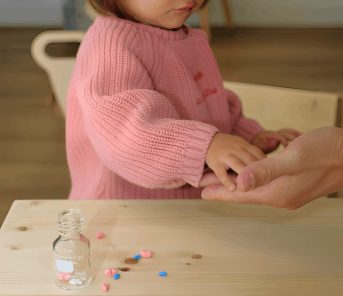How can pharmaceutical 3D printing help our children ?
Administering medication to a child is not a trivial gesture. For some illnesses, children do not always have access to suitable treatments. Pharmaceutical 3D printing appears as an effective alternative to meet their growing needs.

Personalized medecine for our children
Currently, for around 38% of children, the pharmaceutical industry does not offer solutions that meet their needs.
Indeed, children present highly varied physiological and anatomical characteristics. The need for the quantity of active ingredient varies greatly from one child to another. However, for certain pathologies, the pharmaceutical industry does not meet the needs of children. That’s why pharmacists address this gap by manually producing medications within pharmaceutical preparations. The manufactured medications are semi-customized because compromises must be made, for example, on dosage adjustments.
MB Therapeutics‘ 3D printing technology provides a sustainable and tailored response to the specific needs of growing children. Medications produced through 3D printing are custom-designed automatically, allowing for precise fulfillment of each child’s individual needs. Moreover, the excipients used in these medications are chosen to be more appropriate for our children compared to traditional liquid suspensions. These liquid suspensions require stabilizing agents that may not correspond to the profiles of the children involved.
By using pharmaceutical 3D printing technology, it is possible to create medication formulations that are safer and better suited to children’s physiology, offering a promising alternative to enhance their health and well-being.
MB Therapeutics and its technology offer the capability to produce automatically personalized dosages with industrial-grade medication quality. This brings about a new level of safety and flexibility, particularly beneficial in pediatric settings.
Taking medication : a piece of cake
A better acceptability is a benefit of 3D printing for young patients. By offering the possibility to create shapes and colors according to our children’s tastes and preferences, they have the choice of orange, blue, a sun, or a star. Taking medication, often difficult, the size and shape will no longer be a constraint. This adaptability provided by custom 3D printing of medications ensures the comfort of our children and revolutionizes the medical experience.
“We know that children have unique medication needs, and we are committed to enhancing their experience by providing oral forms tailored to their needs“, Stéphane Roulon
For certain age groups, the risks of choking and indigestion are also a concern. Regarding liquid suspensions, they may contain excipients (inactive pharmaceutical ingredients) with known effects or contraindications for certain age groups. This adds to the risks of administration errors with dosing pipettes. 40% of parents make mistakes in administering treatment to their children, which can cause adverse effects for the child.
This personalization goes beyond aesthetics to address practical aspects of treatment. Precisely tailored dosages for each case avoid problems related to under-dosing or overdosing.
Conclusion
MB’s personalized pediatric medication 3D printing represents a promising advancement in the pharmaceutical field. By providing tailored solutions for our children, medication administration becomes a simpler and more inclusive process.



